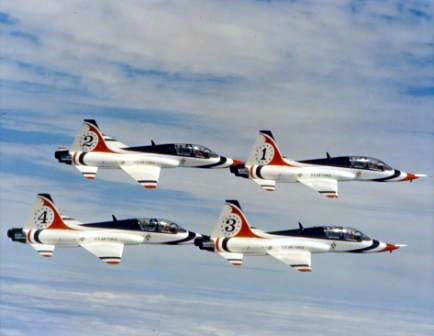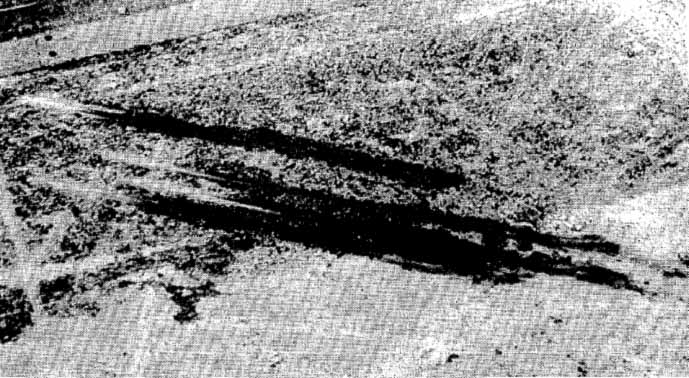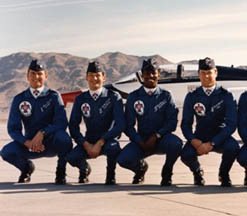The Thunderbirds' "Diamond Crash" At Indian Springs Auxiliary Air Base, Nevada January 18, 1982 A New Leader...
On September 8, 1981, the commander of the Thunderbirds since 1979, Lt. Col. David L. Smith, 40, was taking off in his T-38 Talon when, shortly after departure from Burke Lakefront Airport, it ingested several seagulls, stalling the engines. Hundreds of spectators and countless downtown office workers watched in horror as the jet plunged downwards toward Lake Erie. Luckily, Smith and Staff Sgt Dwight Roberts, 31, the crew chief riding tandem behind him, both ejected from the plane.
But Smith's ejector seat chute did not have time to open, and he impacted on rocks next to the lake and rolled into the water, killing him instantly.  With the loss of their leader, and with the approach of autumn, the 1981 air show ended for the unit. A new leader, Major Norman Lowry, had already been selected by the Air Force to command the team after Smith. With Lowry leading, a fresh start after the loss of Smith and second solo Nick Hauck, who had been killed in another mishap in May of '81, began. With the loss of their leader, and with the approach of autumn, the 1981 air show ended for the unit. A new leader, Major Norman Lowry, had already been selected by the Air Force to command the team after Smith. With Lowry leading, a fresh start after the loss of Smith and second solo Nick Hauck, who had been killed in another mishap in May of '81, began.
Four months later... The four "Diamond" aircraft, Thunderbirds #1, 2, 3, and 4 (tail numbers 68-8156, 8175, 8176 & 8184), were training for an air show at Davis-Monthan Air Force Base, Arizona. Climbing side-by-side for several thousand feet in a slow, backward loop, then hurtling down at more than 400 mph, leveling off at about 100 feet, in a maneuver called a "line-abreast loop," a malfunction in the lead plane, Thunderbird #1, occurred. "At the speed they were going when they came out of the loop, I just thought, "That's the end of that for them fellows,'" said W.G. Wood of Indian Springs, who witnessed the crash as he drove along U.S. 95. "It happened so fast I couldn't tell you if one hit sooner. It looked like all of them hit at the same time."  George LaPointe, a construction worker, watched the jets disappear behind tree tops, "They didn't come back up," he said. "They were going full tilt, really screaming, and at the time I thought they were too low." George LaPointe, a construction worker, watched the jets disappear behind tree tops, "They didn't come back up," he said. "They were going full tilt, really screaming, and at the time I thought they were too low."
A resident across the highway from the auxiliary base where the flight team practiced said he heard the whine of the red, white and blue jets as they climbed to a high arch, then the scream of the engines as they plunged downward to complete the maneuver. "Then boom-boom-boom, boom-boom-boom as they hit the ground one after another," said Loren Conaway. Following their leader to the end, all four planes plowed in the ground. All four pilots were killed instantly. Caught on Tape... Technical Sergeant Al King, was filming on the ground that morning at Indian Springs when the accident occurred. While the sound didn’t work, the video part did, and it would help the accident board determine the cause of the accident. The investigation found that there was insufficient back pressure on the control stick of Thunderbird #1 during the loop. Major Norm Lowry was buried at Riverside National Cemetery in Section 2, Site 1919, in California. Captain Pete Peterson was buried in Culpepper National Cemetery, VA, in Section G, Site 1114, and Captain Willie Mays was buried in his hometown of Ripley, Tennessee. Captain Melancon was buried in Dallas along his father, Air Force Major James Melancon, who died Sept. 24, 1957, when the B-26 he was piloting crashed in a residential area near Dayton, Ohio. | 
| From Left to Right: Major Norm Lowry, 37, of Radford, VA - commander/leader Captain Willie Mays, 32, of Ripley, TN - left wing Captain Joseph Peterson, 32, of Tuskegee, AL - right wing Captain Mark E. Melancon, 31, of Dallas, TX - slot |
|
From the Ashes... The crash opened public debate on such federally-funded aerial exhibition teams, Some argued that groups like the Thunderbirds were "hot-shot stunt pilots" who were spending too much of the taxpayers' dollars, and risking lives in the process. But cooler heads prevailed - those who understood the value to military recruitment and on January 26, 1982, Congress passed Resolution 248, stating that "The Congress hereby affirms its strong support for continuation of the Thunderbirds program." But the 1982 air show season was cancelled for the Thunderbirds while they rebuilt their team. The "Diamond Crash," as it was later called, led to the Thunderbirds upgrading their T-38s to the frontline F-16A "Fighting Falcon" jet fighter, built by General Dynamics, for their performances. In order to rebuild the team, the Air Force pulled several former Thunderbird pilots, who were still on active duty, to "come out of air show retirement", get qualified in flying the F-16A, and had them start flying in "two-ship" formations through all the aerobatic maneuvers, starting in August of 1982, and led by Major Jim Latham. Slowly, the team expanded - one airplane at a time - back up to the full formation of six airplanes. A memorial in honor of the fallen is located on the western wall of the North Las Vegas Police Department's headquarters. At the United States Air Force Academy, a T-38 painted in Thunderbirds color scheme is decidated to the team and its then-leader, Major Lowry. Range 65 is now referred to as "The Gathering of Eagles Range" - an annual aviation event that encourages the study of aviation history and the contributions of aviation pioneers at Air Command and Staff College. In 2005, Indian Springs Air Force Auxiliary Field officially changed its name to Creech Air Force Base in honor of General Wilbur L. “Bill” Creech, who was known as the “father of the Thunderbirds.” |
